

When you think of Japanese theater, you also think of kabuki: demonic-looking masks, elegant kimonos and drums. Often stories are told of old warriors or longing lovers. The beautiful hand-made costumes, the enchanting stage design and the musical background make a journey unforgettable in Kabuki-za.
The Kabuki-za in Ginza is Tokyo's premier kabuki theater. The theater was originally built in 1889 by a Meiji-era journalist Fukuchi Gen'ichiro. Fukuchi wrote kabuki plays and kyogen, another form of traditional Japanese theater, for Ichikawa Danjuro IX and others in which he starred. However, after Danjuro IX's death, Fukuchi retired from the theater. Destroyed by several disasters, the building was rebuilt a total of 4 times.
If a whole Kabuki piece is too long (a piece can take over 4 hours) or too expensive, there is also the option of purchasing tickets for individual acts. For certain pieces, you can also purchase a G-marc guide on site, which translates what is spoken into English so that you can better understand what is happening on stage.
Hibiya Line or Asakusa Line, "Higashi Ginza" Station. Exit 3- direct access to the theatre from the subway station.

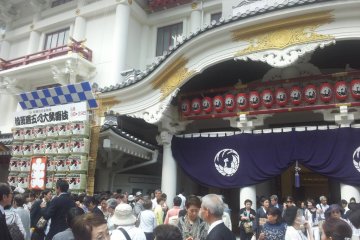
The lavish home of Kabuki in Tokyo - a recently rennovated theater in the heart of Ginza where you can admire the amazing costumes of traditional Japanese theater.
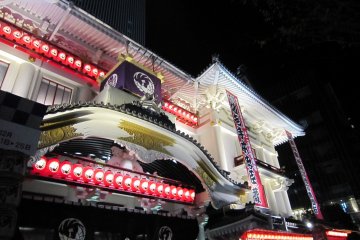
Kabuki-za theater in Ginza is the magnificent edifice of Kabuki in Japan. You can watch Kabuki play while drinking & eating in a box seat. This is a highly recommended once in a lifetime affordable luxury
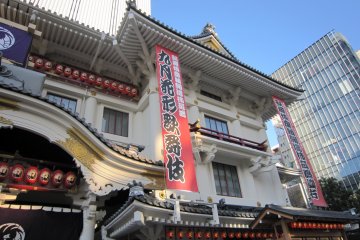
Kabuki is one of the traditional Japanese performing arts which has over 400-year history. I would highly recommend you try it out once in your lifetime at the newly-renovated Kabuki-za in Ginza.
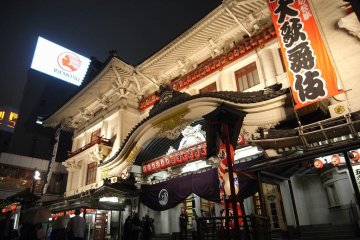
Want to enjoy a kabuki performance but worried about the time and price? A single ticket act is the answer.

Ginza's Kabukiza is staging daily performances in May to honour the great kabuki actors Danjuro IX and Kikugoro V. Tickets are on sale now.

Watching a kabuki performance at Kabukiza in Ginza is easy with a one-act ticket and can help you learn more about Japanese culture. The show was bright, understandable and unforgettable.

At the Ginza kabuki theater, Kabukiza, fans of theatre and traditional Japanese culture can enjoy performances of kabuki at Japan's most famous theatre.

Oakwood Premier Tokyo comes from a brand of standout luxury hotel & service apartments right at the heart of the Tokyo metropolis. It is located in the business hub of Marunouchi with JR Tokyo Station in close proximity. This will allow guests and travelers to easily access the city's extensive transport network and visit various landmarks such as Imperial Palace, Tsukiji Fish Market, Ginza and Shopping District. Boasting 123 luxurious apartments on the upper floors of a multi-serviced complex, each room offers a magnificent view of the city, not to mention all furnished and a fully-equipped kitchen set which is rarely seen in your everyday service apartment. Without doubt, these spacious tranquil retreats are curated to give you the amenities and services of a luxury hotel and a feeling of home. They are good options for both business executives and leisure travelers from one night of a short-stay to a few weeks/months of mid-to-long-term stay.

NOHGA HOTEL AKIHABARA TOKYO is conveniently located in the midst of the electric town Akihabara, also known as the capital of manga and anime. In addition, this neighborhood has an abundance of tech shops, maid cafes and a variety of restaurants. With just a 6-minute walk away from Akihabara station, it provides easy access to explore other areas nearby such as Ueno and Asakusa. This hotel embodies the rich cultures of music, art and food. Nohga’s concept of music is derived from Akihabara’s local history, starting as a district of radio and wireless component merchants in the late 1920s. The artistic and luxurious space throughout the hotel is achieved by featuring art and amenities designed in collaboration with craftsmen from around Japan. As for the food menu, it’s seasonal fresh ingredients are sourced domestically. The glasses and dinnerware served are collaborations with stores in the surrounding area. All 120 non-smoking guest rooms feature an ensuite bathroom with a rain shower, in-room safety box, mini fridge, USB plugs, free Wi-Fi, a high-quality bluetooth speaker and flatscreen TV with original music and film. The lounge area and a compact 24-hour gym can be found near the reception on the second floor. Services include laundry (from 2,750JPY) and a 24-hour front desk with a check-in time of 3PM and check-out time of 11AM. For sightseeing you can rent a Tokyobike for the day (2,000 JPY/day) to explore the vicinity.

ANA Holiday Inn Tokyo Bay (previously Dai-ichi Hotel Tokyo Seafort) is a 132-room hotel that will provide visitors to Japan’s capital city with an attractive, fresh option in the midscale space. ANA Holiday Inn Tokyo Bay will join a strong portfolio of 10 ANA Holiday Inn open and pipeline hotels across Japan, and become part of the brand’s global footprint of 1,234 open hotels and 278 pipeline properties.
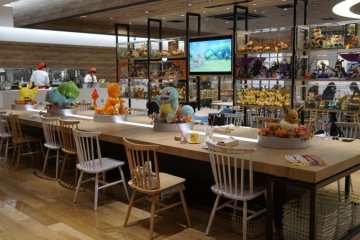
The Pokémon Café in Nihonbashi, which opened in March 2018, is the latest character café in the popular series of games and series in Tokyo. The café and the adjacent Pokémon Center DX store were opened in 1997 on the occasion of the 20th anniversary of the first store. The bright café, which is furnished in warm wood tones, offers main courses, desserts and drinks - all of which are arranged with a focus on one or more Pokémon and some are suitable and limited to certain topics or seasons. You can also find exclusive merchandise here - from plush toys in chef jackets to bowls and cutlery with Pokémon motifs. They also sell Pikachu Sweets, special sweets and products with the most popular of all Pokémon as a motif. A visit to the Pokémon Café is only possible with a prior reservation, time slots can be selected from one month in advance and also in English via the website. It is located on the 5th floor of the Nihombashi Takashimaya Shopping Center, which is not far from the Tokyo and Nihonbashi stations.

Toyosu Market is a wholesale market in Tokyo located in the Koto District. It was built on man-made land in Tokyo Bay and replaces the historic Tsukiji Fish Market, which was previously the capital's famous fish market. Opened October 2018 and is the largest seafood market in the world. The market in turn consists of two separate fish markets, one for auctions and the other for general sale, plus a fruit and vegetable market. There are also restaurants and a variety of options for visitors. Tourists can watch the market from a viewing platform on the second floor and take part in guided auctions and events. However, it is no longer possible, as was previously the case in Tsukiji, for visitors to be directly at the famous tuna events, a platform was built for this, from which one can see into the interior of the market. The modern building complex also offers a roof terrace and a shrine and is easily accessible by bus and train.
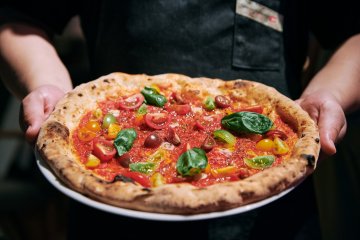
PIZZERIA & BAR NOHGA is an all day dining restaurant interpreting a fusion of “Spanish Italian” cuisine and has a kitchen to table design. There is a casual bar area and restaurant where you can take a peek inside the open kitchen whilst enjoying your meal. Visit the cafe for a range of coffees and teas along with an offering of tapas snacks and seasonal desserts. The cafe also offers an assorted dessert and all-you-can-drink cafe set. Breakfast takes on the art of sharing, where a range of platters are combined with focaccia and your choice of eggs cooked your way. Coming for lunch? Choose from a selection of pizzas, pastas and salads. Each lunch menu is accompanied with homemade soup, iced tea and focaccia. Dinner time offers a range of exquisite tapas and pizzas that can also be shared. Breakfast: 07:00 - 10:00, Lunch 11:30 - 14:30, Cafe 14:30 - 18:00, Dinner: 18:00 - 23:00 with last order at 10pm.

The new Ginza Sony Park will refresh the Ginza area by bringing a splash of color and life to this city district. Visitors can look forward to lush green spaces, shops, and restaurants. The lower park will encompass above-ground and below-ground structures to create a wide and open feeling in an otherwise cramped city. Currently, guests can visit a few eateries and kiosks that have already opened. Phase two will involve creating a green park space to provide the public of Ginza with a “vertical stroll”. The architecture of both structures promises to be something innovative and seamless with the surrounding Ginza. Visitors can look forward to visiting a space designed with Sony characteristics of unparalleled playfulness.

Encounter all types of fresh foods and traditional Japanese foods in Tsukiji’s Outer Market. The market combines wholesale and retail shops into charm that lines the streets of the area and offers a unique perspective on Japan and even some original Japanese dishes. The Tsukiji Market was once a wholesale market for professionals and a place that tourists frequently visited. Particularly famous was the morning fish market where freshly caught fish would be cut and sold in large open areas of the market. Nowadays, the wholesale fish market has since moved to Toyosu (about 2 km away) back in 2018. However, this doesn’t mean that the Outer Tsukiji Market isn’t worth visiting. Colorful slices of fresh-sliced sashimi, dried seaweed, fruits, vegetables, single-servings of food, and kitchen utensils; you can find all this and more at the Outer Market in Tsukiji. In fact, many of the shops in the Outer Market simply bring their wares from Toyosu. In the Outer Market, there are buildings that are more than 80 years old. Many owners still use the first floor for their shops and live on the upper floors above street level creating an intricate maze of homes and shops. But even with this layout, Tsukiji Outer Market is a fascinating place to visit and shop. Especially for sushi and sashimi aficionados. The birth of the fish market as its known today began in 1657 when Edo was devastated by a great fire. Land was reclaimed from Tokyo Bay and named Tsukiji (築地), which means "constructed land". What was once a quiet living quarters for samurai families and shrines—one of which still sits at the back corner of the Tsukiji Market, "Namiyoke" offering protection from waves—became a hustling center of prosperous markets after the 1923 Great Kanto Earthquake. Even though half of the fish market has moved to Toyosu, the Outer Market remains a fascinating experience where tourists can rub elbows with locals and get a sense of where the fresh seafood of Tokyo comes from. The market typically opens for business at 9 am and goes on until 3 pm. This early closing time means that you want to get there early for the freshest foods before they sell out or are closed for the day. Tokyo's wholesale fish market moved to Toyosu in October 2018. Note that many shops are closed on Sundays and some Wednesdays.
![Tokyo Sports Square [Closed] Tokyo Sports Square [Closed]](https://a3.cdn.japantravel.com/photo/poi-54-214274/360x240!/tokyo-tokyo-sports-square-214274.jpg)
The 2019 Rugby World Cup and the 2020 Olympic Games in Tokyo prompted the renaming of the building previously known as the 1000-day theater in Tokyo Sports Square. Tokyo Sports Square is used for event preparations and is intended to provide information directly to fans. It is planned that the wonderful sides of Tokyo will also be shown to advantage. You can enjoy food and drinks here while watching the exciting games on a big screen. Current updates of all favorite teams are also available here. There is also an exhibition of uniforms and mascots. Tokyo Sports Square will also be used to broadcast news about the Tokyo Olympics.